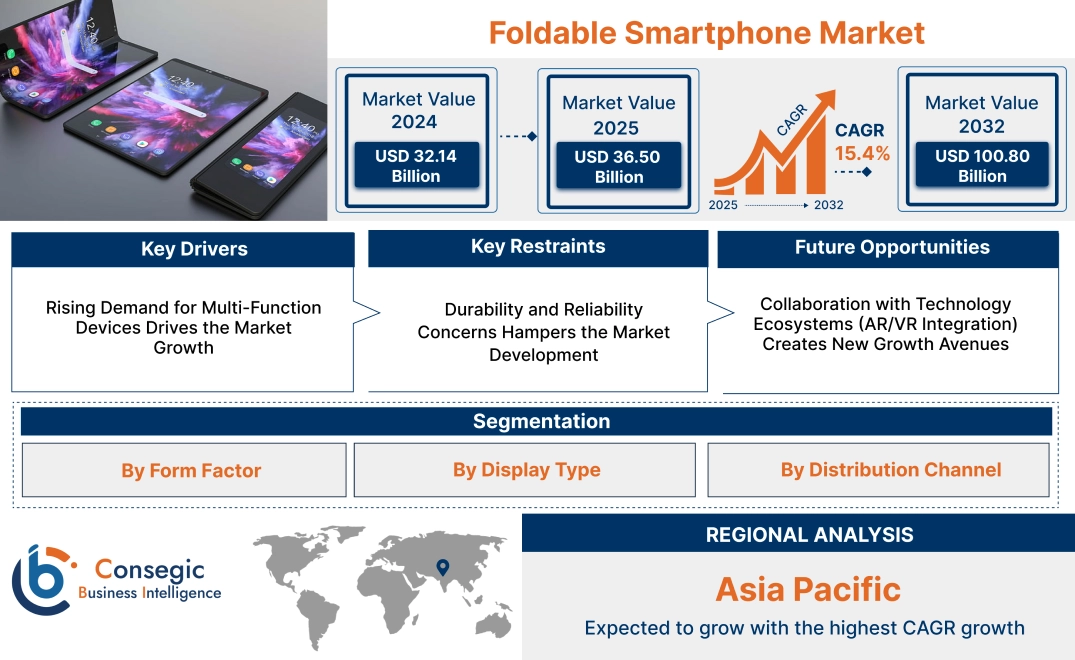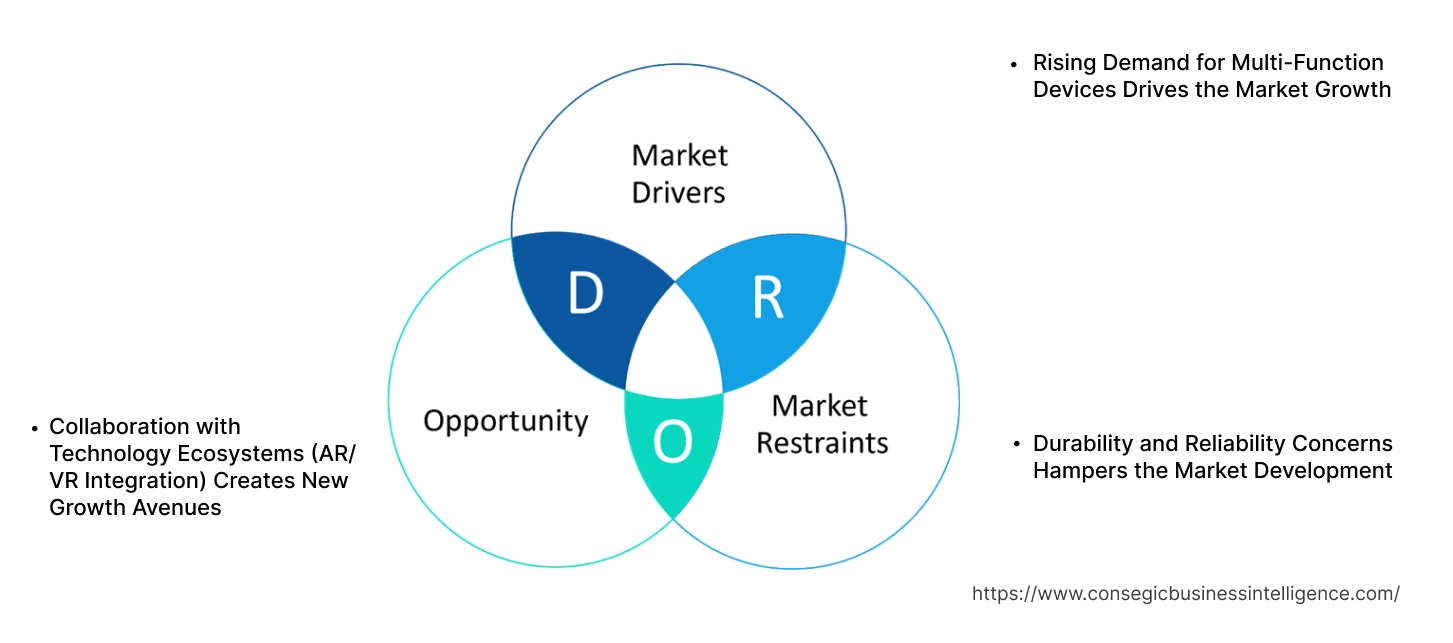- Summary
- Table Of Content
- Methodology
Foldable Smartphone Market Size:
Foldable Smartphone Market size is estimated to reach over USD 100.80 Billion by 2032 from a value of USD 32.14 Billion in 2024 and is projected to grow by USD 36.50 Billion in 2025, growing at a CAGR of 15.4% from 2025 to 2032.
Foldable Smartphone Market Scope & Overview:
A foldable smartphone is a mobile device designed with a flexible display that allows it to fold and unfold, offering users a compact form factor with an expanded screen experience. These devices incorporate advanced hinge mechanisms and durable display materials to ensure seamless folding functionality without compromising performance. They are widely used for multitasking, media consumption, and productivity applications.
These smartphones come in various designs, including inward-folding and outward-folding configurations, catering to different user preferences. They feature high-resolution flexible OLED or AMOLED screens, ensuring vibrant visuals and responsive touch functionality. Many models also integrate multi-window capabilities, adaptive interfaces, and enhanced durability to support daily usage.
End-users include tech-savvy consumers, professionals, and multimedia enthusiasts who seek innovative mobile solutions with enhanced screen versatility. Foldable smartphones play a pivotal role in redefining user experiences by combining portability with an immersive display.
Key Drivers:
Rising Demand for Multi-Function Devices Drives the Market Growth
Despite the innovative features offered by foldable smartphones, concerns over durability and reliability remain significant barriers to widespread adoption. The folding mechanism, which includes hinges and flexible displays, is a critical component of the device’s design but is prone to wear and tear over time. Frequent folding and unfolding of the device strains these mechanisms, leading to potential malfunctions or reduced performance, which impacts the smartphone’s longevity. Additionally, the flexible displays, though advanced, are still susceptible to damage from prolonged use or pressure, raising doubts about the device’s overall durability. These concerns, particularly regarding the lifespan of the hinges and displays, deter consumers from investing in these smartphones, especially those looking for long-term reliability. Manufacturers must address these issues by improving materials and engineering solutions to enhance the device’s durability. Thus, the above mentioned factors limit the foldable smartphone market growth.
Key Restraints:
Durability and Reliability Concerns Hampers the Market Development
Consumers are increasingly seeking devices that combine multiple functions into a single, versatile tool. Foldable smartphones meet this need by offering the convenience of a compact, portable device for everyday use, while also providing the functionality of a larger, tablet-like screen when unfolded. This dual functionality is ideal for tasks such as gaming, video streaming, productivity, and multitasking, allowing users to enjoy a more immersive experience without needing multiple devices. The ability to switch seamlessly between a phone and a tablet-like interface makes these smartphones particularly appealing to tech-savvy consumers who value convenience, performance, and innovation. As the demand for multifunctional devices grows, it fuels the foldable smartphone market demand by offering a unique, all-in-one solution for a wide range of consumer needs.
Future Opportunities :
Collaboration with Technology Ecosystems (AR/VR Integration) Creates New Growth Avenues
The large, flexible screens of foldable devices offer an immersive platform for AR/VR content, enabling users to interact with digital environments in new and dynamic ways. In gaming, foldable smartphones will provide a more engaging, console-like experience, while in education, they offer interactive learning tools through AR. For professional applications, such as design, architecture, or remote collaboration, the combination of foldable screens with AR/VR enables more intuitive and efficient workflows. This integration will unlock entirely new use cases for these smartphones, pushing the boundaries of how these devices are used in both personal and business contexts. As AR/VR adoption grows, these smartphones will become a central device for immersive digital interactions, further creating foldable smartphone market opportunities.
Foldable Smartphone Market Segmental Analysis :
By Form Factor:
Based on form factor, the market is segmented into flip phones, fold-out smartphones, fold-in smartphones, and others.
The fold-in smartphones segment accounted for the largest revenue of the total foldable smartphone market share in 2024.
- Fold-in smartphones feature an inward folding design, protecting the main display when not in use, making them a preferred choice for durability and longevity.
- These devices provide a seamless transition between a compact phone mode and a larger tablet-like experience, enhancing user convenience for multitasking and media consumption.
- Leading smartphone manufacturers continue to refine fold-in designs, integrating high-performance chipsets, improved hinge mechanisms, and enhanced battery efficiency.
- As per foldable smartphone market analysis, advancements in flexible display technology and reinforced screen materials are driving increased consumer adoption of fold-in smartphones.
The flip phones segment is anticipated to see steady adoption during the forecast period.
- Flip-style foldable smartphones offer a compact design, making them attractive to users seeking a balance between portability and advanced smartphone features.
- These devices maintain the traditional clamshell design while incorporating high-resolution foldable screens and advanced camera technology.
- The segment benefits from growing consumer interest in retro-inspired designs combined with modern smartphone capabilities.
- As per foldable smartphone market trends, flip phones are gaining traction among users who prioritize compact designs without compromising on premium functionality.
By Display Type:
Based on display type, the market is segmented into OLED, AMOLED, MicroLED, and others.
The AMOLED segment accounted for the largest revenue of 51.2% of the total foldable smartphone market share in 2024.
- AMOLED displays are widely used in foldable smartphones due to their superior color accuracy, high contrast ratios, and energy efficiency.
- These displays enhance the user experience with deeper blacks, vibrant colors, and smoother motion rendering, making them ideal for media consumption and gaming.
- Leading manufacturers continue to invest in AMOLED-based foldable screens with improved durability, reducing the risk of creases and screen degradation over time.
- Thus, ongoing research in AMOLED technology focuses on increasing display longevity and optimizing battery efficiency, which fuels the foldable smartphone market demand.
The MicroLED segment is expected to experience increasing adoption during the forecast period.
- MicroLED technology offers superior brightness, energy efficiency, and durability compared to traditional OLED and AMOLED displays.
- These displays provide enhanced resistance to burn-in effects, making them a promising alternative for foldable devices that require frequent screen folding and unfolding.
- Manufacturers are actively exploring MicroLED panels for future foldable smartphone models, aiming to improve overall display quality and longevity.
- As per foldable smartphone market trends, the shift toward ultra-thin, high-performance foldable screens is driving innovation in MicroLED technology.
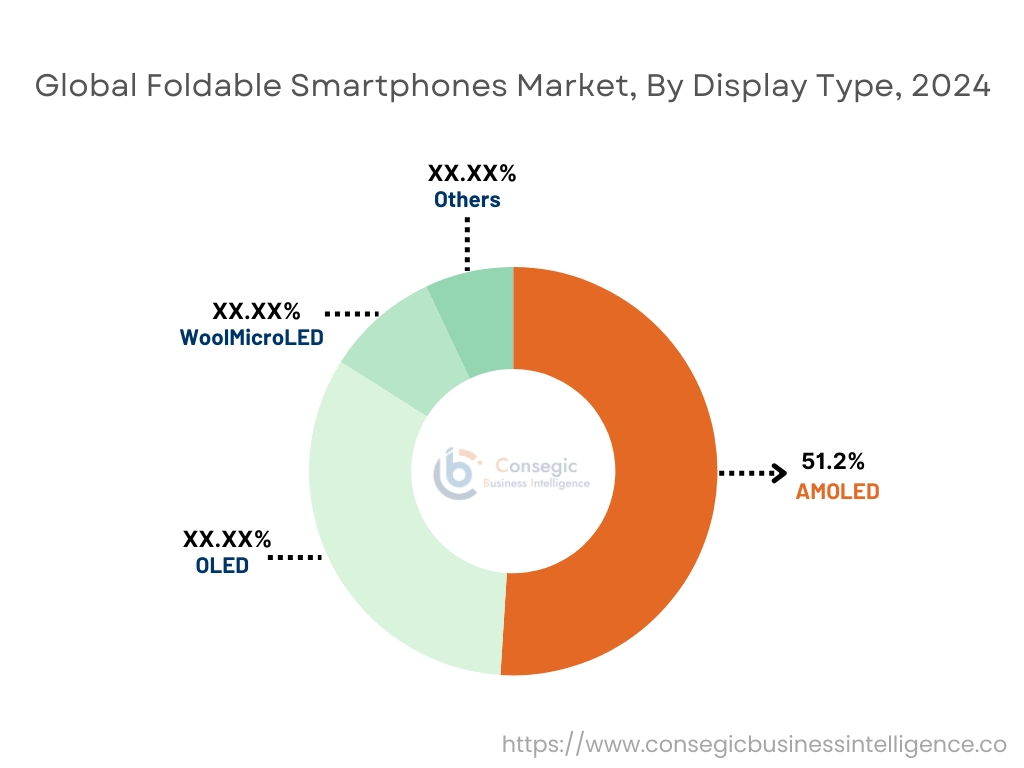
By Distribution Channel:
Based on distribution channel, the market is segmented into online retail and offline retail.
The offline retail segment accounted for the largest revenue share in 2024.
- Consumers prefer offline retail channels, such as brand-exclusive stores and electronics showrooms, to experience foldable smartphones firsthand before purchasing.
- Retail stores provide personalized assistance, allowing customers to compare form factors, test screen durability, and explore device usability.
- The segment benefits from brand promotional activities and in-store financing options, making these high-end smartphones more accessible to consumers.
- Physical retail outlets continue to play a vital role in sales, particularly in premium and flagship product categories, boosting the foldable smartphone market expansion.
The online retail segment is projected to expand rapidly during the forecast period.
- The convenience of online shopping, coupled with exclusive discounts and trade-in offers, has led to an increasing number of consumers purchasing foldable smartphones online.
- E-commerce platforms enable direct-to-consumer sales, offering customization options and flexible financing plans to attract a wider audience.
- Virtual product demos and AR-based features enhance the online shopping experience, providing consumers with insights into these smartphone usability.
- As per industry trends, the rising penetration of e-commerce platforms and digital-first shopping preferences are expected to drive significant adoption of online retail channels, driving the foldable smartphone market growth.
Regional Analysis:
The regions covered are North America, Europe, Asia Pacific, the Middle East and Africa, and Latin America.
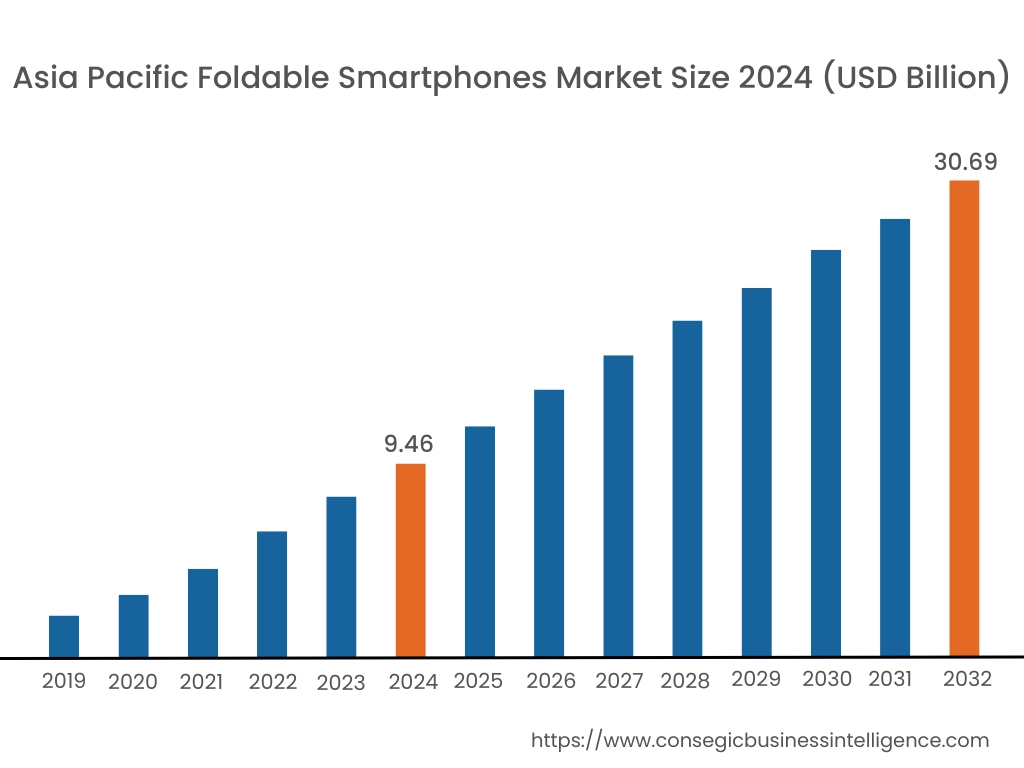
Asia Pacific region was valued at USD 9.46 Billion in 2024. Moreover, it is projected to grow by USD 10.78 Billion in 2025 and reach over USD 30.69 Billion by 2032. Out of this, China accounted for the maximum revenue share of 31.9%. The Asia-Pacific region, particularly China, currently dominates the global foldable smartphone market. A prominent trend is the rapid innovation and investment by domestic brands such as Huawei, Oppo, and Vivo in foldable smartphone research. Analysis indicates that these manufacturers are launching affordable mass-market models, differentiating their offerings through aggressive pricing and promotions, and efficiently meeting demand through direct dealings with local carriers and distribution channels.
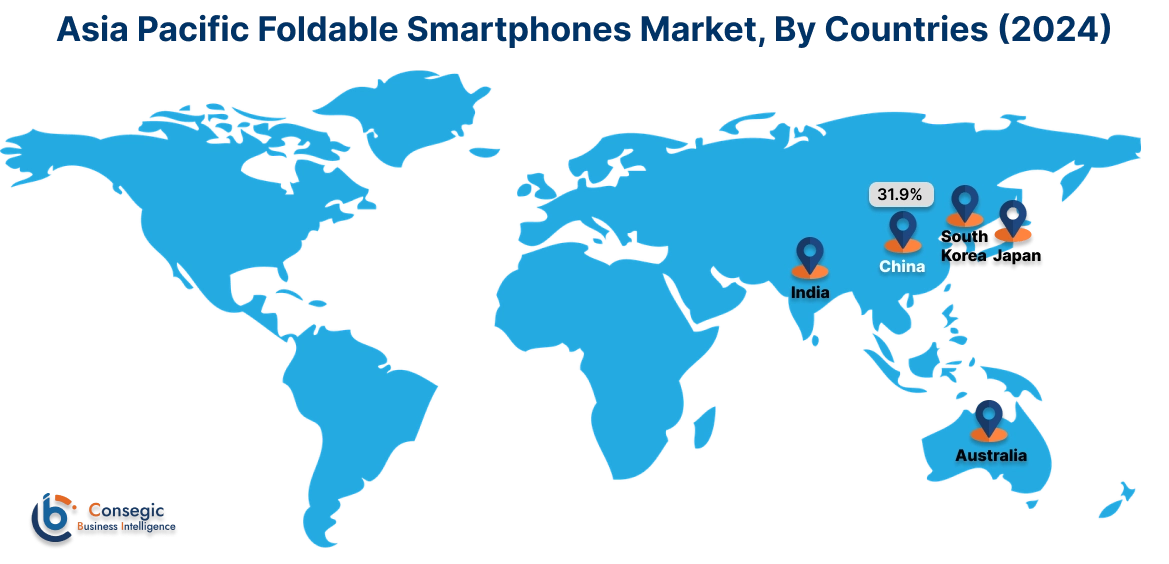
North America is estimated to reach over USD 32.67 Billion by 2032 from a value of USD 10.66 Billion in 2024 and is projected to grow by USD 12.08 Billion in 2025. In this region, there is a notable trend towards adopting foldable smartphones, driven by consumer demand for innovative devices that offer both portability and expanded screen real estate. Analysis indicates that major technology companies have established strong research and development centers, allowing them to closely monitor market trends and design smartphones tailored to North American consumers. Furthermore, the foldable smartphone market analysis shows that rising disposable incomes contribute to a willingness to invest in premium devices, further propelling the market growth.
European countries are witnessing a surge in the adoption of foldable smartphones, with a significant trend being the entry of Chinese manufacturers into the premium segment. Analysis suggests that brands like Realme, Oppo, and Honor are intensifying efforts to expand their market share by offering high-margin premium devices, leveraging new technologies such as foldable displays and advanced cameras to compete with established players.
In the Middle East and Africa, the foldable smartphone market is influenced by growth in appetite for advanced consumer electronics. The focus is on introducing devices that combine innovative design with enhanced functionality to cater to tech-savvy consumers. Analysis suggests that partnerships with global technology providers and the increasing availability of high-speed internet are contributing to the foldable smartphone market expansion in these regions.
Latin American countries are increasingly recognizing the potential of foldable smartphones in offering versatile user experiences. A notable trend is the gradual introduction of foldable devices by international brands, aiming to capture the interest of consumers seeking the latest technological advancements. Analysis indicates that economic development and the growth in middle-class population are key factors influencing the foldable smartphone market opportunities in this region.
Top Key Players and Market Share Insights:
The Foldable Smartphone market is highly competitive with major players providing products and services to the national and international markets. Key players are adopting several strategies in research and development (R&D), product innovation, and end-user launches to hold a strong position in the global Foldable Smartphone market. Key players in the Foldable Smartphone industry include -
- Samsung Electronics Co., Ltd. (South Korea)
- Huawei Technologies Co., Ltd. (China)
- Google LLC (USA)
- Xiaomi Corporation (China)
- Motorola Mobility LLC (USA)
- LG Electronics Inc. (South Korea)
- Sony Corporation (Japan)
Recent Industry Developments :
Product Launches:
- In September 2024, TECNO officially launched the PHANTOM V Flip 5G, its first flip-style foldable smartphone, featuring a compact design and flagship specifications. The device boasts a 6.9-inch FHD+ main display with a 120Hz refresh rate and an innovative 1.32-inch circular cover screen for quick interactions. Powered by the MediaTek Dimensity 8050 chipset, it offers 8GB RAM and 256GB storage. The PHANTOM V Flip 5G includes a 64MP main camera, 13MP ultra-wide lens, and a 32MP front camera with autofocus. Its 4000mAh battery supports 45W fast charging.
- In July 2024, Samsung unveiled the Galaxy Z Fold6 and Z Flip6, featuring advanced AI capabilities. The Z Fold6 includes AI-powered Note Assist for translation, summaries, and formatting, along with voice transcription and AI-generated sketches. The Z Flip6 enhances photography with AI-driven Portrait Studio and FlexCam for hands-free shots. Both devices run on the Snapdragon 8 Gen 3 Mobile Platform, offering improved AI processing and graphics. Durability is enhanced with a dual rail hinge and reinforced folding edges. Samsung continues to integrate AI into its foldables for a more efficient and personalized user experience.
- In October 2023, OnePlus launched its first foldable smartphone, the OnePlus Open. This flagship device features a Hasselblad Camera for Fold, a Snapdragon® 8 Gen 2 processor, 16GB LPDDR5X RAM, and 512GB UFS4.0 storage. It boasts a sleek design and aims to deliver a fast and smooth user experience.
- In October 2023, OPPO globally launched the Find N3 and Find N3 Flip foldable smartphones. The Find N3 features dual flagship displays and a professional-grade imaging system, while the Find N3 Flip introduces a flagship triple-camera setup with a telephoto lens. Both models aim to enhance user experience in imaging, design, and usability.
Foldable Smartphone Market Report Insights :
| Report Attributes | Report Details |
| Study Timeline | 2019-2032 |
| Market Size in 2032 | USD 100.80 Billion |
| CAGR (2025-2032) | 15.4% |
| By Form Factor |
|
| By Display Type |
|
| By Distribution Channel |
|
| By Region |
|
| Key Players |
|
| North America | U.S. Canada Mexico |
| Europe | U.K. Germany France Spain Italy Russia Benelux Rest of Europe |
| APAC | China South Korea Japan India Australia ASEAN Rest of Asia-Pacific |
| Middle East and Africa | GCC Turkey South Africa Rest of MEA |
| LATAM | Brazil Argentina Chile Rest of LATAM |
| Report Coverage |
|
Key Questions Answered in the Report
What is the size of the Foldable Smartphone Market? +
The Foldable Smartphone Market size is estimated to reach over USD 100.80 Billion by 2032 from a value of USD 32.14 Billion in 2024 and is projected to grow by USD 36.50 Billion in 2025, growing at a CAGR of 15.4% from 2025 to 2032.
What are the key segments in the Foldable Smartphone Market? +
The market is segmented by form factor (flip phones, fold-out smartphones, fold-in smartphones, others), display type (OLED, AMOLED, MicroLED, others), and distribution channel (online retail, offline retail).
Which segment is expected to grow the fastest in the Foldable Smartphone Market? +
The online retail segment is projected to expand rapidly during the forecast period due to the increasing convenience of e-commerce platforms and digital-first shopping preferences.
Who are the major players in the Foldable Smartphone Market? +
Key players in the Foldable Smartphone Market include Samsung Electronics Co., Ltd. (South Korea), Huawei Technologies Co., Ltd. (China), Motorola Mobility LLC (USA), LG Electronics Inc. (South Korea), Sony Corporation (Japan), Google LLC (USA), Xiaomi Corporation (China).
